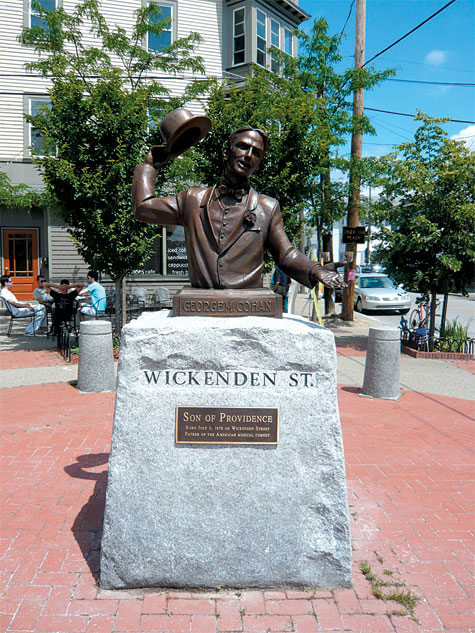
SONG AND DANCE MAN Cohan, in bronze.
|
The hipsters ambling past the new George M. Cohan bust at the corner of Wickenden and Governor streets this week seemed more concerned with ducking out of the July rain than gazing upon statuary.
But it was more than showers that separated the graduate students and punk rockers from Cohan, the Providence native who penned "The Yankee Doodle Boy," "Over There," and "You're a Grand Old Flag," among other patriotic tunes.
The Broadway impresario, who provided the American soundtrack for World War I and World War II, is an emblem of a time that can seem impossibly distant for the young and skeptical: a time of unabashed pride in country.
He was of an era, said Michael Fink, a Cohan aficionado and professor of English at the Rhode Island School of Design, when freedom meant something other than the opportunity to criticize.
"In my generation," Fink said, "we were free to love America."
Fink, who delivered a lecture on Cohan last weekend as part of the ceremonies surrounding the unveiling of the statue, grew up in the Providence, singing Cohan tunes in the Summit Avenue School glee club.
When he was eight, Fink said, President Roosevelt declared war on the Axis. He had uncles, including an Uncle Sam, who served in the war. A Providence Journal photograph captured him pinning a world map to trace their movements.
"[Cohan's] songs," he said, "took on a very, very intense emotional meaning."
But whatever his resonance in Providence, the songwriter, actor, and dancer — who lived most of his life in New York — merited little more than a plaque in the Fox Point neighborhood of his birth until last week.
Ironically, it took a pair of New York transplants, Sy and Judi Dill, who moved to Providence to be closer to a daughter and grandchildren, to push for something more meaningful.
Cohan, known as "the man who owned Broadway," had a statue in Times Square. And the Providence plaque, Sy Dill said, just didn't measure up. "I thought, 'My God, they can do better than that,' " he said.
The couple formed an ad hoc committee, raised a little money, and commissioned Robert Shure, the Woburn, Massachusetts, sculptor who designed the Irish Famine Memorial in Providence, to create the bust — an eager Cohan lifting his hat above his head with his right hand and gesturing forward with his left.
"I wanted to kind of get the spirit of him," said Shure.
Cohan, portrayed by James Cagney in the 1942 biopic Yankee Doodle Dandy, was not the idealized figure of the film. He divorced once. Clashed with the Broadway actors union. He had some warts.
And for the children of the Watergate era, the warts are the thing. Or are they?
The youthful embrace of Barack Obama — still strong seven months into his administration — suggests a longing for a new sort of patriotism. Perhaps not Yankee Doodle Dandy. More critical than that. More reserved.
But something hopeful and proud, nonetheless.
The young and liberal-minded were not free to love America under President Bush. But now, for the hipsters ambling past that bust of George M. Cohan, an opening.
Editor's Note: In a previous version of this article Sy Dill was incorrectly identified as Sy Gill. The correction has been above.